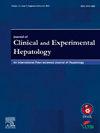Diagnostic Accuracy of the LiverRisk Score to Detect Increased Liver Stiffness Among a United States General Population and Subgroups
IF 3.3
Q2 GASTROENTEROLOGY & HEPATOLOGY
Journal of Clinical and Experimental Hepatology
Pub Date : 2025-02-06
DOI:10.1016/j.jceh.2025.102512
引用次数: 0
Abstract
Background
The LiverRisk score (LRS) has recently been proposed to predict liver fibrosis and future development of liver-related outcomes in the general population. Here, we performed an external validation of this score.
Methods
We used data from National Health and Nutrition Examination Survey 2017-2020, a United States population-based cohort to assess the diagnostic accuracy of the LRS to detect a liver stiffness measurement (LSM) ≥8 and ≥12 kPa. Performance was tested among the entire general population and clinically relevant subgroups.
Results
The cohort comprised 7,025 participants (aged 49 [33-63], 49% male), and 9.7% had an LSM ≥8 and 3.2% had an LSM ≥12 kPa. The area under the receiver characteristic operator curve (AUC) in the overall population was 0.73 (95% confidence interval [CI] :0.71-0.75) and 0.78 (95% CI: 0.74-0.81) to detect an LSM ≥8 and ≥ 12 kPa, respectively, significantly outperforming the fibrosis 4 index (FIB-4) but not the nonalcoholic fatty liver disease fibrosis score, steatosis-associated fibrosis estimator (SAFE), or metabolic dysfunction–associated fibrosis 5 (MAF-5). Performance was consistent among most subgroups, but AUC levels to detect an LSM ≥8 kPa decreased to <0.70 among participants aged 18-40 or 60-80 years, blacks, and individuals with diabetes or liver steatosis. The LRS categorized 80.5% as very low risk, 17.7% as low risk, and 1.8% as at risk, prevalence of an LSM ≥8 in these groups was 6.3%, 20.8%, and 50.5%, respectively. The sensitivity to detect an LSM ≥8 kPa was 47.3% in the overall population (but dropped to 21.3% for individuals aged 18-40 years) despite applying the lowest cut-off, which should yield the highest sensitivity.
Conclusion
The LRS score is a promising new tool to predict liver fibrosis; however, its diagnostic accuracy attenuates especially among patients aged 18-40 or 60-80 years. The overall sensitivity was only 47.3% at the lowest LRS cut-off. Further studies assessing cost-benefit ratios according to the LRS compared to FIB-4 and other risk scores such as MAF-5 and SAFE are required to determine its usefulness in referral strategies.

在美国普通人群和亚组中检测肝僵硬增加的肝脏风险评分的诊断准确性
肝风险评分(liver risk score, LRS)最近被提出用于预测普通人群的肝纤维化和肝脏相关结局的未来发展。在这里,我们对这个分数进行了外部验证。方法:我们使用2017-2020年美国人群队列国家健康与营养调查的数据,评估LRS检测肝脏硬度测量值(LSM)≥8和≥12 kPa的诊断准确性。在整个普通人群和临床相关的亚组中测试了性能。结果该队列包括7025名参与者(49岁[33-63],49%为男性),9.7% LSM≥8 kPa, 3.2% LSM≥12 kPa。总体人群中受试者特征操作曲线(AUC)下面积分别为0.73(95%可信区间[CI]:0.71-0.75)和0.78 (95% CI: 0.74-0.81),用于检测LSM≥8和≥12 kPa,显著优于纤维化4指数(FIB-4),但优于非酒精性脂肪肝纤维化评分、脂肪变性相关纤维化估计值(SAFE)或代谢功能障碍相关纤维化5 (ma -5)。大多数亚组的表现是一致的,但在18-40岁或60-80岁、黑人和糖尿病或肝脂肪变性患者中,检测LSM≥8kpa的AUC水平降至0.70。LRS将80.5%归为极低风险,17.7%归为低风险,1.8%归为高危,LSM≥8的患病率分别为6.3%,20.8%和50.5%。尽管采用最低临界值,但总体人群中检测LSM≥8 kPa的灵敏度为47.3%(但在18-40岁的个体中下降到21.3%),这应该产生最高的灵敏度。结论LRS评分是一种有前景的预测肝纤维化的新工具;但在18-40岁或60-80岁的患者中,其诊断准确性下降。在最低LRS截止时,总体敏感性仅为47.3%。根据LRS与FIB-4和其他风险评分(如MAF-5和SAFE)比较,需要进一步的研究来评估成本效益比,以确定其在转诊策略中的有效性。
本文章由计算机程序翻译,如有差异,请以英文原文为准。
求助全文
约1分钟内获得全文
求助全文
来源期刊

Journal of Clinical and Experimental Hepatology
GASTROENTEROLOGY & HEPATOLOGY-
CiteScore
4.90
自引率
16.70%
发文量
537
审稿时长
64 days
 求助内容:
求助内容: 应助结果提醒方式:
应助结果提醒方式:


